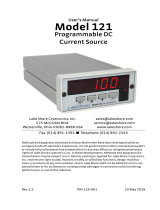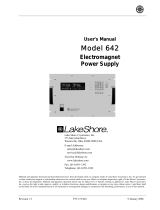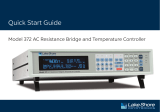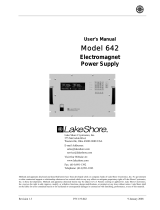Page is loading ...

User’s
Manual
Digital Cryogenic
Thermometer
Model
DRC-80
Obsolete
Notice:
This manual describes an obsolete Lake Shore product. This manual is a copy from our archives
and may not exactly match your instrument. Lake Shore assumes no responsibility for this manual
matching your exact hardware revision or operational procedures. Lake Shore is not responsible
for any repairs made to the instrument based on information from this manual.
Lake Shore Cryotronics, Inc.
575
McCorkle Blvd.
Westerville, Ohio
43082-8888
USA
Internet Addresses:
Visit Our Website:
www.lakeshore.com
Fax:
(61 4) 891-1392
Telephone:
(61
4)
891-2243
Methods and apparatus disclosed and described herein have been developed solely on company funds
of
Lake Shore Cryotronics, Inc.
No
government or other contractual support or relationship whatsoever has existed which in any way affects or mitigates proprietary
rights of Lake Shore Cryotronics, Inc. in these developments. Methods and apparatus disclosed herein may be subject to
U.S.
Patents
existing or applied for. Lake Shore Cryotronics, Inc. reserves the right to add, improve, modify, or withdraw functions, design
modifications, or products at any time without notice. Lake Shore shall not be liable for errors contained herein or for incidental
or
consequential damages in connection with furnishing, performance, or use of this material.
Obsolete
Manual
July
1981

Table of Contents
I.
General Information
1.1 Introduction 1
1.2 Description
1
1.3 Major Assemblies Supplied 2
1.4 Ordering of Replacement or Additional Sensors 3
11.
Installation
2.1 Introduction
4
2.2 Initial Inspection
4
2.3 Power Requirements
4
2.4 Grounding Requirements
4
2.5 Installation
4
2.6 Repackaging for Shipment 5
III.
Operating Instructions
3.1 Introduction
7
3.2 Controls, Indicators, Connectors 7
3.3 Temperature Readout
8
3.4 Analog Output of Temperature 13
3.4.1 Field Installation
of
DRC Options
-
8022 and 8025 13
3.5 Standard DT-500DRC and DT-500CU-DRC-36 Curves 13
3.6 Rack Mounting the DRC-80 13
3.7 The 10-Sensor Selector Switch 13
3.8 Remove Parallel BCD Output Option 15
3.9
IEEE Interface Option
18
3.9.1 General IEEE Specifications
&
Operation 18
3.9.2 Specific Operation of the DRC8-IEEE Interface,
19
3.9.3 Sample Programming 20
3.9.4 Field Installation
of
DRC-IEEE, Model 8024 21
Model 8024
IV. Theory
of
Operation
4.1 Introduction 22
4.2 Detailed Description 22
4.2.1 Power Supplies 22
4.2.2 Precision Constant Current Source and Front 23
4.2.3 A/D Converter and Microprocessor System 23
4.2.4 Software
-
DRC-80 Cryogenic Thermometer 24
4.2.5 Digital Display Board 26
Panel Switching
V. Calibration and Troubleshooting
5.1 Introduction 27
5.2 Test Equipment 27
5.3 General Remarks 27
5.4 Instrument Calibration 27
5.4.1 Current Source 27
5.4.2 A/D Converter 28
5.4.3 Adjustment
of
Output Buffer 28
5.4.4 DRC8-L/A Option Model 8025 28
5.5 Instrument Tests
28
VI.
DRC-80 Replaceable Parts List 31 ii

Table of Illustrations
Figure
1.1
Figure 2.1
Table 3.1
Figure 3.1
Figure 3.2
Table 3.2
Figure 3.3
Figure 3.4
Figure 3.5
Table 3.3
Table 3.4
Figure 3.6
Figure
4.1
Table 5.1
Figure
5.1
Figure
6.1
Figure 6.2
Figure 6.3
Figure
6.4
Figure 6.5
Figure 6.6
Figure
6.7
Figure
6.8
Model DRC-80 Digital Cryogenic Thermometer
Sensor, Cable, and Monitor Connections
Entry Number Correlation
DRC-80 Front Panel
DRC-80 Rear Panel
DT-500DRC(D curve) Voltage-Temperature
Characteristic
Model DRC-80 shown with RM-3H Rack
Mounting Hardware
Model DRC-80 and SW-10A shown with RM-3H
Rack Mounting Hardware
Model DRC-80 and SW-10A Rear View showing RM-3H
Rack Mounting Hardware and Umbilical Cord
Connections
SW-10A Connector Detail
BCD Temperature Output
-
Model 8022
DRC80-IEEE-488, Model 8024, Panel Layout
Software Flow Diagram for DRC-80 Digital
Thermometer
DRC-80 Signals Associated with Fig. 5.1
DRC-80 Signals
DRC-80 Power Supply Schematic
DRC-80 Main Board Schematic
DRC-80 Main Board Component Layout
DRC-80 Display Schematic
DRC-80 BCD-L/A, Model 8022/25, Schematic
DRC-80 BCD-L/A, Model 8022/25, Component Layout
DRC-80 IEEE-488, Model 8024, Schematic
DRC-80 IEEE-488, Model 8024, Component Layout
iv
6
7
9
9
10
14
14
14
16
17
21
25
29
30
36
37
38
39
40
41
42
43
iii

Specifications,
DRC-80
Thermometer
Input:
Temperature Range:
1.4 to 330K with standard DRC
Sensor (to 380K with other Sensors).
Sensor:
Silicon Diode (order separately). DT-500-DRC,
DT-500CU-DRC-36 or any calibrated DT-500 Series Diode.
See below for proper response curve.
Sensor Input:
Dual-sensor input. 4-terminal input for each
sensor. Selection is via front-panel pushbuttons.
Sensor Excitation:
10-microampere current source. Stabil-
ity
±0.005%.
Sensor Response Curve:
Domestic
US
units require Sensor
Curve "D". Export units require Sensor Curve
"E".
Sensor
curves subject to change, refer to manual for proper curve
when reordering Sensors. Curves to match existing Sen-
sors available on special request. See also DRC-Precision
Option.
Input Resistance:
Greater than 1000 megohms.
Maximum Sensor Power Dissipation:
25µW at 4.2K
Temperature Readout:
Display:
4-digit, 1.1cm (0.43") LED shows temperature
directly in Kelvin.
Resolution:
0.1 K. "Scale Expand" increases resolution to
0.01 K for temperatures below 30K. 0.05K from 30K to 100K
(no increase in accuracy).
Accuracy (20-25°C ambient):
±0.5K at 4K and 77K,
±1
.OK at
330K with standard Sensor. See DRC-Precision Option for
accuracy with Lake Shore calibrated Sensor.
Temperature Coefficient (10-20°C and 25-45° ambient):
±0.01 K/°C.
Response Time:
Less than 1 second to rated accuracy.
General:
Monitor Output:
Buffered output of Display Sensor voltage
(additional outputs listed below as options).
Dimensions, Weight:
216mm wide
x
102mm high
x
330mm
deep (8.5 in x 4 in
x
13 in). Style L. half-rack package. Net
weight 3.6 kg (7.9 Ibs).
Power:
90-110, 105-125, or 210-250VAC (switch-selected),
50
or 60Hz.
Accessories Supplied:
Mating connectors for sensor inputs
and monitor, instruction manual.
Options and Accessories Available:
Model 8022.
Parallel BCD output for DRC-80. TTL compat-
ible. Provides BCD output of temperature in Kelvin and
Sensor selected (either from front-panel or optional
Model 8024.
IEEE-488 output for DRC-80. Provides digital
output of temperature in Kelvin and Sensor selected
(either from front-panel or optional SW-10A).
Model 8025.
Analog output proportional to Kelvin tempera-
ture
for use
with
recordersorother readouts. 10mV/K
at
<
10
ohm output resistance (field installable)
.
Model 8022/25.
Combination of 8022 (BCD output) and
8025 (Analog output) installed in same unit.
Model SW-10A.
10-Sensor Selector Switch for use with
DRC Thermometer
or
Controller. Push-button selection of
any one of up to 10 sensors. Connects to Sensor "B"
position of instrument. Sensor selected is
also
identified
via 8022 or 8024 digital interfaces. Dimensions: 216mm
wide
x
102mm high x 330mm deep (8% in x 4 in x 13 in).
Style L half-rack package
.
Model
RM-3H.
Rack mounting hardware to mount either
one or two Style L half-rack unit(s) in standard 3%" rack
space.
DRC-Precision Option:
Custom-programmed read-only-
memory for DRC instruments which improves specified
accuracy to 0.1 K or better over a given calibration range.
Any DT-500 Series Silicon Diode Sensor can be utilized.
Requires that an appropriate calibration be purchased for
the Sensor. Specify Sensor input position (A or B or 1-10 on
SW-10A) to assure proper location of calibration within
PROM. First calibration stored
.
Subsequent calibrations stored in same PROM
.
Model DT-500-DRC Sensor.
Silicon Diode Temperature
Sensor for DRC-80 (1.5mm diameter
×
4.1mm
long). Specify
response curve
.
Model DT-500CU-DRC-36.
Silicon Diode Temperature
Sensor for DRC-80 (8mm diameter x 3.3mm thick with
mounting hole). Specify response curve.
SW-10A)
.
FIGURE
1.1
Model
DRC-80
Digital Cryogenic Thermometer
iv

SECTION
I
General In
f
o
r ma
t
i
on
1.1 Introduction
The following is a description of the DRC-80 Cryogenic Digital
Thermometer. The DRC-80 Series
of
instruments is designed to be used with
the Model DT-500-DRC and DT-500CU-DRC-36 silicon diode sensors manufactured
by Lake Shore Cryotronics, Inc.
Several different diode sensor curves are available for use with this
instrument. When ordering replacement sensors, care must be taken to assure
that the correct sensor curve is specified. Multiple curves are needed
so
that Lake Shore can assure the customer that replacement sensors
will
be
available at any time in the future. For details, please see Section 1.4.
1.2 Description
The DRC-80 Series is comprised of completely self-contained units
providing direct digital readout in Kelvin temperature units and, for the
controllers, temperature control by direct analog comparison between the
sensor voltage and an analog equivalent of the digital temperature set point.
The DRC-80 displays temperature to
0.1
Kelvin over its operating range of
1-400
Kelvin for normal operation. In the scale expand mode, the resolution
is
0.01
Kelvin below 30 Kelvin and 0.05 Kelvin from 30K to
100
Kelvin.
The specified range of operation is
4.0
to 380K* utilizing standard
DRC series sensors which have been pre-selected to provide uniform character-
istics over this range. These sensors conform to the standard table (see
Table 3.3) to 0.5K or better below 77K and better than
1
Kelvin above 77K.
The instrument, however, displays down to 1K although accuracy is only speci-
fied above 4K. Pre-selection allows the DRC-80 Series to be used with the
DT-500-DRC and DT-500CU-DRC-36 sensors without adjustments of any kind. Since
the standard sensors are interchangeable, the instruments may be used to read
out any number of sensors with equal accuracy when selected through an appro-
priate switch such as the
SW-10A.
The DRC-80 has dual sensor inputs. Sensor selection is made via front-
panel pushbuttons.
As
a standard feature, all units are equipped with buffered analog
output of the display sensor voltage. This allows the instrument user the
ability to record the display sensor voltage versus time or to use a digital
voltmeter to measure the display sensor voltage directly. Since this output
‘is buffered, a high input impedance recorder or voltmeter is not required.
*If possible, temperatures above 330K should be avoided with DRC Series
sensors since these sensors may slightly shift their values below 20K
if
heated above 330K.
-1-

If the sensor is calibrated by the user or by Lake Shore Cryotronics, Inc.,
temperature may be determined to approximately 10mK.
Five options are available with the DRC-80 Series of instruments.
One option is an analog signal which is proportional to temperature
(Model
8025)
and has a sensitivity of
10
mV/K.
A second option is a ten-position switch SW-10A for multiple sensor
readout. This switch is a separate half-rack
box
which plugs into the Sensor
"B"
position of the DRC-80. The sensor selected is also identified via digi-
tal interface of the DRC-80, if present.
Another option is a custom cut PROM (DRC-Precision Option) which corres-
ponds to the calibration curve of the customer's DT-500 Series sensor.
A
combination of a calibration and custom cut PROM
will
increase display accur-
acy to better than
.1
Kelvin over the calibrated range. Please note that any
sensor may be used with this option, i.e., the customer is not restricted to
the DRC Series sensors.
There are two computer options available; each will output the displayed
temperature and sensor selected from the SW-10A. The Model 8022 is
in
a
parallel BCD format while the Model 8024
is
in the popular IEEE-488 format.
The DRC-80 Series is designed around an 3870 microprocessor and associ-
ated support circuits. The DRC curve is stored in a PROM which can handle up
to 32 break points. The data consists of a table of temperature and voltage
associated with each break point. These straight line segments can generate
the DRC curve to an accuracy of better than
0.1
Kelvin over the entire tempera-
ture range
(4.0
-
400
K).
1.3 Major Assemblies Supplied
The DRC-80 Series includes as standard equipment, in addition to the
digital thermometer-controller, the following:
A. Operating and Servicing Manual
B. Two five Pin Plugs for Temperature Sensor Cables
C.
One seven Pin Plug for Monitor of Sensor Output Voltage and the
DRC8-L/A option
Model DT-500 Series silicon diodes are not supplied as part of the
DRC-80 instrument.
Complete Specifications, Accessory Equipment and Customs Options are
listed in the front of the Manual.
-2-

1.4
Ordering of Replacement or Additional Sensors
Two different sensor configurations are available for use with the
Model DRC-80 Series instruments. These are the DT-500-DRC and the DT-500CU-
DRC-36 sensors. Their description is included elsewhere in this manual. All
sensor configurations are available if the diode is calibrated and a special
PROM
is
cut.
More than one curve presently exists which can be used with the DRC-80
Series instruments. If additional sensors are ordered for use with your
instrument, you must be certain to order the correct curve
so
that your
instrument
will
have its stated accuracy. The proper curve may, be determined
in
one of the following ways:
A.
Specify the sensor serial number that is currently being used
with the instrument (serial number is found on the end of the
plastic box in which the sensor was received).
B.
Specify the serial number
of
your instrument. Our records
will
indicate with which sensor the instrument is compatible.
C. Remove the top
of
your instrument and observe the indicator on
the
PROM.
D. The fourth way is to measure the diode voltage at
4.2K
and
give this value to Lake Shore Cryotronics, Inc. when re-
ordering sensors.
-3-

This
Page Intentionally Left Blank

SECTION II
Installation
2.1 Introduction
This section contains information and instructions necessary for the
installation and shipping of the model DRC-80 Cryogenic Thermometer. Included
are initial inspection instructions, power and grounding requirements, install-
ation information and instructions for repackaging for shipment.
2.2 Initial Inspection
This instrument was electrically and mechanically inspected prior to
shipment. It should be free from mechanical damages, and in perfect working
order upon receipt. To confirm this, the instrument should be inspected visual-
ly for obvious damage upon receipt and tested electrically by use to detect any
concealed damage. Be sure to inventory all components supplied before dis-
carding any shipping materials. If there is damage to the instrument in tran-
sit, be sure to file appropriate claims with the carrier, and/or insurance
company. Please advise the company of such filings. In case of parts' short-
ages, please advise the company. The standard Lake Shore Cryotronics warranty
is given on the title page.
2.3 Power Requirements
Before connecting the power cable to line voltage, insure that the instru-
ment is of the proper line voltage and fused accordingly. The line voltage and
fuse are shown on the rear panel of the instrument.
The line voltage can be changed by switching line voltage selector switch
(S2
-
Figure
6.3
DRC-80 Component Layout) located on the main printed circuit
board of the unit.
Nominal permissible line voltage fluctuation is
±10%
at 50 to
60
Hz.
2.4 Grounding Requirements
To protect operating personnel, the National Electrical Manufacturer's
Association
(NEMA)
recommends, and some local codes require, instrument panels
and cabinets to be grounded. This instrument is equipped with a three-
conductor power cable which, when plugged into an appropriate receptacle,
grounds the instrument.
2.5 Installation
The DRC-80 Thermometer is all solid state and does not generate signifi-
cant heat. It may therefore be rack mounted in close proximity to other equip-
ment in dead air spaces. The heat from such adjacent equipment should not
subject the thermometer to an ambient temperature in excess of 50°C
(122°F).
-4-

As with any precision instrument,
it
should not be subjected to the shock and
vibrations which usually accompany high vacuum pumping systems.
The recommended cable diagrams for the sensor diodes are shown in Figure
2.1 (a). The use of a four wire diode connection is highly recommended to
avoid introducing lead IR drops which
will
occur if the alternate two lead
sensor cable connection is used. For example, for a two lead connection, every
25 ohms of cable resistance corresponds to a
.1
K error above
30
Kelvin. The
alternate wiring scheme shown in Figure 2.1 (b) may be used for the diode
in
less critical applications where lead resistance can be kept small. The indica-
ted shielding connections are the recommended standard practice to avoid ground
loops.
2.6 Repackaging for Shipment
Before returning an instrument to the factory, should repair be neces-
sary, please discuss the malfunction with a factory representative. He may be
able to suggest several field tests which will preclude returning a satisfac-
tory instrument to the factory when the malfunction is elsewhere. If it is
indicated that the fault is in the instrument after these tests, the represen-
tative
will
provide shipping and labeling instructions for returning
it.
When returning an instrument, please attach a tag securely to the
instrument itself (not on the shipping carton) clearly stating:
A. Owner and Address
B. Instrument Model and Serial Number
C. Malfunction Symptoms
D. Description of External Connections and Cryostats
If the original carton is available, repack the instrument
in
a
plastic bag, place in carton using original spacers to protect protruding
controls, and close carton. Seal lid with paper or nylon tape. Affix
mailing labels and "FRAGILE" warnings.
-5-

This
Page Intentionally Left Blank

SECTION III
Operating Instructions
3.1
Introduction
This section contains a description
of
the operating controls and
their adjustment under normal operating conditions, and typical controller
applications. These instructions are based upon the instrument having been
installed as outlined in Section
II.
The diode polarity
as
shown in Figure
2.1
(a), in particular, must be correct.
3.2
Controls, Indicators, Connectors
The operating controls, indicators and connectors on the DRC-80
instrument's front and rear panels are shown
in
Figures
3.1,
and
3.2.
The numbers with leaders to various controls in the figures are keyed
to the entries in Table
3.1.
Table
3.1
-
Entry Number Correlation
1
2
3
4
5
6
7
8
POWER
Scale Expand
Sensor B
Sensor A
NO LABEL
NO LABEL
Fuse
Sensor A
A.C. line switch (ON/OFF) (Display serves
as indicator light).
With button out, the display reads to
0.1K
at all temperatures; with button in detent
position, temperature reads to
0.01K
below
30K, 0.05K
between
30K
and
100K,
and to
0.1K
above
100K.
Selects Sensor B.
Selects Sensor A.
Digital temperature display located behind
filter panel. Sensor displayed depends on
sensor selected.
A.C. line cord
A.C. line fuse
Sensor input lead terminals (Pin A,
I+,
Pin
E,
V+,
Pin B, I-, Pin D,
V-,
Pin
H,
Shield).
-7-

9
10
11
Monitor
Sensor B
Interface
Analog output of sensor voltage (0-2.5v,
Pin
A)
and optional linear analog output
of temperature(0-4V, Pin C). Pin B is
ground for sensor voltage while Pin
D
is ground for
L/A
output.
Same as Sensor
A
BCD input of set point/output of
temperature. Also
IEEE
interface port.
3.3 Temperature Readout
The sensor(s) and heater should be installed following the sugges-
tions listed in the "Installation and Application Notes for Cryogenic
Sensors" brochure in Section VIII.
Connect the sensor(s) to the instrument following the diagram in
Figure
2.1.
Depress the power switch and observe that the display shows the
proper temperature relative to the sample temperature.
The sensor and readout display should follow the curve in Table
3.2.
This curve illustrates typical values expected of the DT-500-DRC or DT-500CU-
DRC-36 sensors.
If the diode or lead wires are shorted, the display
will
read
----.
If
the diode is connected backwards, the display
will
read
428.0
for all
curves. In the case of an open current or voltage lead, the display
will
slowly drift higher in temperature. The curves and appropriate PROM mark-
ings are given below:
Curve
0
A
B
D
E
PROM U13
Version
3
Version
6
Version
2
Version
4
Version
5
If the instrument or sensor does not agree with values listed in
the table, within the accuracy of the system, consult sections on instal-
lation and/or section on troubleshooting to determine the cause and cure
of the malfunction.
-8-

FIGURE
3.1
DRC-80
Front Panel
FIGURE
3.2
DRC-80
Rear Panel
-9-

Table
3.2
DT-500DRC (D) Voltage-Temperature Characteristic
30
29
28
27
26
25
1.4
1.5
1.6
1.7
1.8
1.9
2.0
2.2
2.4
2.6
2.8
3.0
3.2
3.4
3.6
3.8
4.0
4.2
4.4
4.6
4.8
5.0
5.5
6.0
6.5
7.0
7.5
8.0
8.5
9.0
9.5
10.0
11.0
12.0
13.0
14.0
15.0
16.0
17.0
18.0
2.5984
2.5958
2.5932
2.5906
2.5880
2.5854
2.5828
2.5735
2.5643
2.5551
2.5458
2.5366
2.5226
2.5086
2.4946
2.4807
2.4667
2.4527
2.4387
2.4247
2.4108
2.3968
2.3618
2.3269
2.2919
2.2570
2.2220
2.1871
2.1521
2.1172
2.0909
2.0646
2.0119
1.9592
1.9066
1.8338
1.7610
1.6984
1.6359
1.5646
-10-

DT-500DRC (D) Voltage-Temperature Characteristic
24
23
22
21
20
19
18
17
16
15
14
13
12
11
10
19.0
20.0
21.0
22.0
23.0
24.0
25.0
26.0
27.0
28.0
29.0
30.0
32.0
34.0
36.0
38.0
40.0
45.0
50.0
55.0
60.0
65.0
70.0
75.0
80.0
85.0
90.0
95.0
100.0
105.0
110.0
115.0
120.0
125.0
130.0
135.0
140.0
145.0
150.0
155.0
1.4932
1.4219
1.3505
1.3006
1.2507
1.2114
1.1720
1.1486
1.1308
1.1190
1.1116
1.1058
1.0970
1.0902
1.0850
1.0798
1.0746
1.0633
1.0520
1.0407
1.0287
1.0166
1.0046
.99172
.97890
.96609
.95327
.93987
.92647
.91307
.89966
.88626
.87286
.85946
.84606
.83228
.81850
.80472
.79094
.77716
-11-

DT-500DRC (D) Voltage-Temperature Characteristic
9
8
7
6
5
4
3
2
1
160.0
165.0
170.0
175.0
180.0
185.0
190.0
195.0
200.0
205.0
210.0
215.0
220.0
225.0
230.0
235.0
240.0
245.0
250.0
255.0
260.0
265.0
270.0
275.0
280.0
285.0
290.0
295.0
300.0
305.0
310.0
315.0
320.'0
325.0
330.0
335.0
340.0
345.0
350.0
355.0
360.0
365.0
370.0
375.0
380.0
.76338
.74961
.73582
.72170
.70757
.69344
,67931
.66518
.65105
.63693
.62280
.60867
.59455
.58080
.56707
.55334
.53960
.52649
.51337
.50026
.48714
.47403
.46057
.44711
.43365
.42019
.40613
.39208
.37802
.36397
.34940
.33482
.32025
.30568
.29111
.27654
,26197
.24739
.23325
.21911
.20497
.19083
.17774
.16464
.15155 -12-

Table 3.2
DT-500DRC (El) Voltage-Temperature Characteristic
30
29
28
27
26
25
24
1.4
1.5
1.6
1.7
1.8
1.9
2.0
2.2
2.4
2.6
2.8
3.0
3.2
3.4
3.6
3.8
4.0
4.2
4.4
4.6
4.8
5.0
5.5
6.0
6.5
7.0
7.5
8.0
8.5
9.0
9.5
10.0
11.0
12.0
13.0
14.0
15.0
16.0
17.0
18.0
2.6591
2.6567
2.6542
2.6518
2.6494
2.6470
2.64k6
2.6355
2.6265
2.6175
2.6084
2.5994
2.5868
2.5742
2.5616
2.5490
2.5364
2.5221
2.5077
2.4934
2.4791
2.4648
2.4290
2.3932
2.3574
2.3216
2.2858
2.2500
2.2142
2.1784
2.1516
2.1247
2.0708
2.0170
1.9632
1.9011
1.8390
1.7769
1.7148
1.6527
-10-

DT-500DRC
(El)
Voltage-Temperature Characteristic
23
22
21
20
19
18
17
16
15
14
13
12
11
10
9
8
19.0
20.0
21.0
22.0
23.0
24.0
25.0
26.0
21.0
28.0
29.0
30.0
32.0
34.0
36.0
38.0
40.0
45.0
50.0
55.0
60.0
65.0
70.0
75.0
77.35
80.0
85.0
90.0
95.0
100.0
105.0
110.0
115.0
120.0
125.0
130.0
135.0
140.0
145.0
150.0
155.0
1.5724
1.4922
1.4120
1.3317
1.2831
1.2357
1.1559
1.1365
1.1239
1.1150
1.1080
1.0981
1.0909
1.1877
1.0848
1.0797
1.0746
1.0630
1.0515
1.0399
1.0284
1.0159
1.0035
0.9911
0.9849
0.9780
0.9649
0.9518
0.9388
0.9257
0.9122
0.8988
0.8853
0.8718
0.8584
0.8449
0.8311
0.8173
0.8035
0.7896
0.7758
-11-
/













